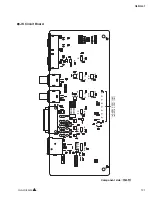
Telink FR1 PCB Design Guideline
AN-22051900-E1 Ver. 1.0.0
18
5.
Routing Notes
Please be noted of the following routing points.
Prioritize the power and RF circuit routings, power wires should be as thick as possible (0.5mm ~ 1mm),
as close as possible to the power supply components or chip end in the use of star alignment
respectively power supply.
Then comes the normal routing, prioritize to route audio lines, and audio lines should have complete
copper on both sides, as shown in Figure 5-1.
For via hole, carbon film hole is needed, pay attention that put the carbon film hole as far as possible
with the routing and other carbon film hole, at least 1mm, to prevent short circuit.
Keep the width of the carbon film routing at 1mm or more to reduce carbon film impedance.
The ground is the main focus for FR1 board design.
Due to the high current jumps during RF operation, the smaller the GND impedance, the better, to
help reduce RF noise. For single-layer board, we should connect each component's ground with
wires after the power routing is completed, giving priority to ensuring that the ground line can go
through, and adding the 0R cross-line resistor at locations where it has blocks.
Ground wire should be as thick as 1mm and above, and routed in a ground shape.
Routing does not require excessive division of the ground plane, that is, the same direction routing
is together, and the routing distance should not be too long to affect the ground backflow. Priority
to ensure that the chip center ground and the power supply negative ground has a good ground
connection.
The crystal should be grounded as much as possible, and the RF components should be completely
grounded and covered with solid copper, as shown in Figure 5-1.
Avoid large areas of solid copper, in the wave soldering process, abnormal heat dissipation, the board is
easy to bulge. When encountering large areas of copper coverage, choose a mesh structure to facilitate
heat dissipation. For key circuits, such as RF, crystal, audio lines, and etc., the complete copper coverage
can be used directly. In addition, for some areas of narrow space, the complete copper should be laid out
to strengthen the ground reflow, as shown in Figure 5-1.



































